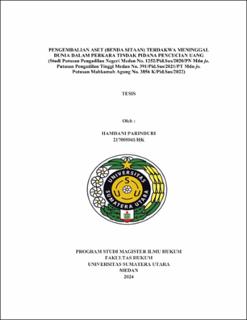| dc.contributor.advisor | Sunarmi | |
| dc.contributor.advisor | Siregar, Mahmul | |
| dc.contributor.advisor | Trisna, Wessy | |
| dc.contributor.author | Parinduri, Hamdani | |
| dc.date.accessioned | 2025-01-16T02:15:41Z | |
| dc.date.available | 2025-01-16T02:15:41Z | |
| dc.date.issued | 2024 | |
| dc.identifier.uri | https://repositori.usu.ac.id/handle/123456789/100189 | |
| dc.description.abstract | Prevention and eradication of money laundering which focuses on persuing assets of the perpetrator from the proceeds of the criminal acts is not solely applicable. The provisions of Article 79 paragraph (4) of Law no. 8 of 2010 concerning Prevention and Eradication of the Crime of Money Laundering which regulates the confiscation of confiscated assets in the event that the defendant dies before the verdict is handed down, does not fully apply so that the confiscated assets are returned to the defendant through his heirs. This research aims to answer what is the legal basis for returning the assets of a deceased defendant in a money laundering crime case? How are the assets of a deceased defendant returned to prove a money laundering crime? What is the analysis of the considerations of the judge and decisions regarding the return of assets of a deceased defendant in a money laundering crime case based on Medan District Court Decision No. 1252/Pid.Sus/2020/PN Mdn jo. Medan High Court Decision No. 391/Pid.Sus/2021/PT Mdn jo. Supreme Court Decision No. 3856 K/Pid.Sus/2022?
The research uses normative legal research methods with an analytical and descriptive nature. The data collection technique used is literature study and the tool used is document study. The research approach uses a statutory and case approach. The data source used is secondary data consisting of primary, secondary and tertiary legal materials. The data analysis method used is qualitative data analysis.
The results show that the return of the assets of a deceased defendant in a money laundering crime case is based on a court decision that has taken into account the juridical basis, is considered appropriate and provides legal certainty regarding the defendant’s confiscated assets, because there is a ruling stating that the confiscated assets are returned to the defendant through his heirs. | en_US |
| dc.language.iso | id | en_US |
| dc.publisher | Universitas Sumatera Utara | en_US |
| dc.subject | Return | en_US |
| dc.subject | money laundering | en_US |
| dc.subject | defendant | en_US |
| dc.title | Pengembalian Aset (Benda Sitaan) Terdakwa Meninggal Dunia Dalam Perkara Tindak Pidana Pencucian Uang (Studi Putusan Pengadilan Negeri Medan No. 1252/Pid.Sus/2020/PN Mdn jo. Putusan Pengadilan Tinggi Medan No. 391/Pid.Sus/2021/PT Mdn jo. Putusan Mahkamah Agung No. 3856 K/Pid.Sus/2022) | en_US |
| dc.title.alternative | Return Of Assets (Confisced Objects) of Defenders Who Died in Money Laundering Crime Cases (Study of Medan District Court Decision No. 1252/Pid.Sus/2020/PN Mdn jo. Medan High Court Decision No. 391/Pid.Sus/2021/PT Mdn jo. Supreme Court Decision No. 3856 K/Pid.Sus/2022) | en_US |
| dc.type | Thesis | en_US |
| dc.identifier.nim | NIM217005041 | |
| dc.identifier.nidn | NIDN0015026304 | |
| dc.identifier.nidn | NIDN0020027303 | |
| dc.identifier.nidn | NIDN0123018601 | |
| dc.identifier.kodeprodi | KODEPRODI74101#Ilmu Hukum | |
| dc.description.pages | 142 Pages | en_US |
| dc.description.type | Tesis Magister | en_US |
| dc.subject.sdgs | SDGs 16. Peace, Justice And Strong Institutions | en_US |


